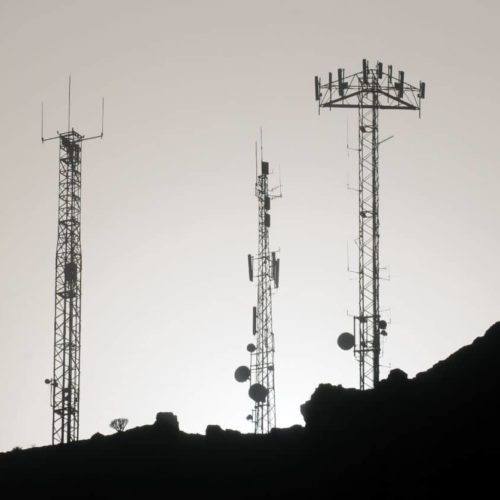Introduction

The setting was ornate, the subject esoteric, but the implications huge.
The crowd that filed last month into the wood-paneled room 226 in the Dirksen Senate Office Building included lawmakers, lobbyists, company executives, and a few mystery guests — a roster that reflected the enormity of the issue at hand: nothing less than control of the growing wireless market and the hundreds of billions of dollars that go with it.
Verizon Communications Inc. and T-Mobile USA Inc. were out in force, as were some of the most powerful lobbyists in Washington, D.C. Along with those household names was the little-known but quietly influential Jonathan Spalter.
The chairman of Mobile Future, a Washington, D.C.-based nonprofit group, sat at the witness table along with the big wireless carriers and well-known consumer advocates to tell senators how the government should auction valuable airwaves that the telecommunications companies say they need to keep up with the exploding use of smartphones and tablet computers.
Spalter told the senators that the best way to ensure a successful auction — one that would best serve customers and promote innovative technologies — is to allow all wireless companies to bid without restrictions on as many frequencies as they want.
What Spalter didn’t reveal is that Mobile Future, which describes itself as “a coalition of cutting-edge technology and communications companies and a diverse group of non-profit organizations,” is funded in part by wireless giants AT&T Inc. and Verizon, which are also advocating for an auction free of limits. The group also didn’t detail that relationship when it submitted three research papers to the Federal Communications Commission arguing against restricting how much spectrum a company can obtain in an auction.
And it didn’t disclose the fact that data from a research paper it used to create a graphic arguing against limits was commissioned by AT&T and filed with the FCC, which is writing rules for the auction. Mobile Future does list AT&T and Verizon as among its 82 members on its website.
Sally Aman, principal of Aman & Associates, the public relations firm hired by Mobile Future, said the committee “is and was fully aware of Mobile Future’s membership.”
But the relationship wasn’t clear to almost anyone watching the proceedings.
“Depending on the outcomes of the spectrum auctions, it could get a whole lot worse in terms of a handful of companies being able to tilt the field in their favor.”
Matthew Hindman, a professor at George Washington University
Orchestration of influence
Mobile Future is just one thread in the massive influence web being deployed by AT&T and Verizon as they fight proposals advocated by their smaller competitors and the Justice Department to limit how much of the new wireless frequencies they’ll be allowed to bid on at the auction that’s scheduled for next year.
The spectrum that’s up for sale is highly coveted because it allows transmissions to travel long distances and penetrate buildings. Good spectrum is crucial for wireless companies to attract customers by delivering an ever-increasing amount of information to smartphones and computer tablets.
The competition for control of the airwaves has set off an intense lobbying fight that rivals some of the largest battles over telecommunications policies of the past. The four biggest carriers together spent $37.3 million in 2013 trying to influence lawmakers and the FCC on a host of policy issues ranging from taxes to cyber security as well as spectrum — and the auction is still more than a year away.
But the carriers led by AT&T and Verizon likely have spent at least twice as much more on behind-the-scenes influence campaigns — hiring Ivy-league academics, giving cash to think tanks, associations and universities, and employing public relations firms — all part of a synchronized effort to sway the FCC to establish rules that favor them, said James Thurber, a professor at American University who has been studying lobbying for 30 years.
“This includes all the advertising, white papers, surveys, grass-roots and top-roots activities going on,” Thurber said. “Lobbying isn’t just what the federal registered lobbyists do. It’s an orchestration of a variety of techniques and influence.”
Battling AT&T and Verizon are Sprint Corp. and T-Mobile, the third- and fourth-largest carriers whose networks and customer bases are dwarfed by their larger rivals. The two have put together their own influence campaigns, hiring teams of paid academics and building connections with consumer groups and associations. But Sprint and T-Mobile are at a disadvantage against the deeper pockets and vast network of political ties of AT&T and Verizon, according to those who track Washington lobbying efforts.
At stake is no less than who may ultimately control the public’s wireless access to the Internet, on which all kinds of data — from medical records and bank transactions to Amazon purchases and movie downloads — travel from providers to smartphones and tablets.
The sale of the newly available airwaves also will determine if the wireless market becomes one ruled by two companies or if a recent burst of competition initiated by T-Mobile will continue, said Harold Feld, a senior vice president at Public Knowledge, a consumer advocacy group in Washington that wants to limit how much spectrum each carrier can purchase in the upcoming auction.
“For wireless carriers, the stakes are enormously high,” Feld said. If the smaller companies are shut out of the auction, “it’s hard to imagine they can overcome that and compete with AT&T and Verizon over time.”



Join the conversation
Show Comments